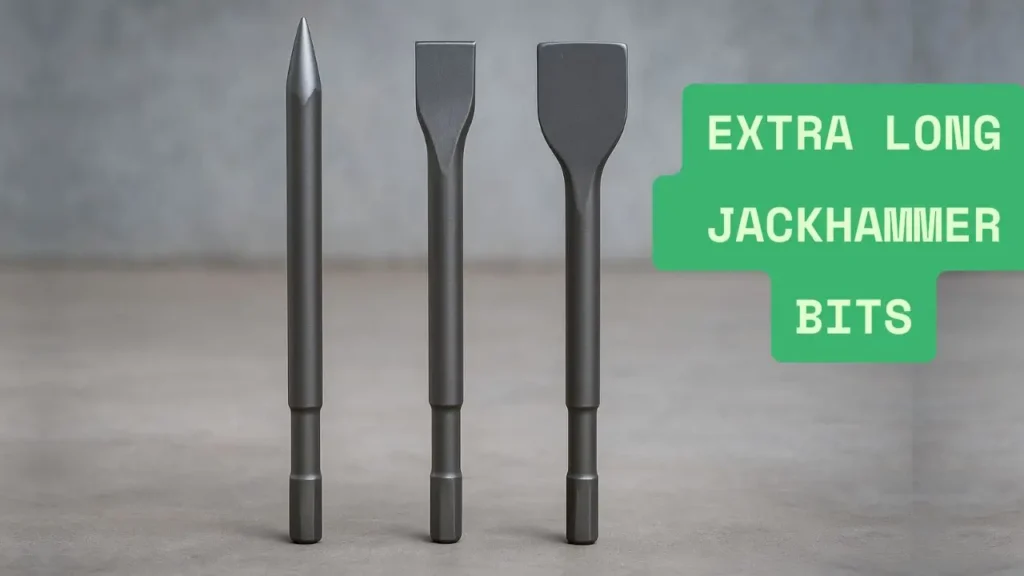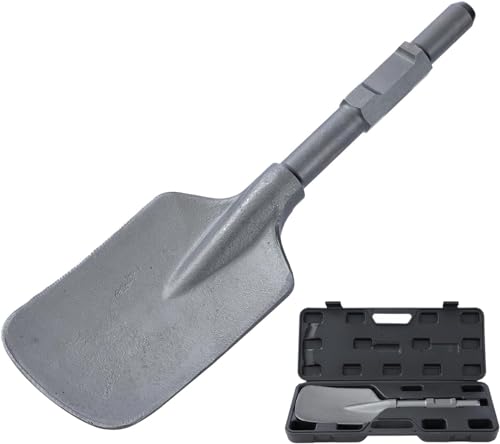Quick Summary: Extra Long Jackhammer Bits: Expert Guide to 6-Foot Extensions
- Content Type: Guide
- Last Updated: August 1, 2025
- Fact-Checked By: Azlan - Smart AI Gears team member
- Affiliate Link Present: Yes
You need extra long jackhammer bits when regular ones fail to reach the work area. These designed extensions stretching up to 1000mm, make difficult demolition tasks doable. Whether digging deep trenches cutting out tree roots, or smashing through thick concrete, these strong tools boost what your equipment can handle in a big way.
To handle tough demolition tasks, jackhammer chisel bits need to endure harsh conditions. Manufacturers design the best extra-long jackhammer bits using chromium-vanadium steel to improve strength and give them excellent resistance against wear, rust, and corrosion. Knowing the different jackhammer bit types is key to getting good results on your project. In this guide, we’ll discuss how to pick, use, care for, and operate these powerful 6-foot extensions. The insights come from over 30 years of manufacturing knowledge to help you choose the right tools for demanding projects.
Disclaimer
Affiliate Disclaimer
I want to be 100% honest with you. Some links you see in my post are ‘affiliate links’. This just means if you click one of my links and then buy a tool, I get a very small money from the shop.
This does not cost you any extra money at all. The price is the same for you.
This small help lets me keep this blog alive and test more tools for you. Please know, I only link to tools I have used myself or received a verified review of the tool and believe are good. My words and my review are my own, nobody pays me to say nice things. Thank you for your support!
Image Information
All product images used in this post are provided by the author and claimed to be their own usage. According to the author, these images are either self-clicked, taken during hands-on testing, or screenshots captured for review purposes. If you believe any image violates your rights, please contact us for proper credit or removal.
Price & Stock Information
The product prices and availability mentioned in this post are accurate as of the time of publishing. However, prices may change on the seller’s website without notice. Please always check the latest price and stock status on the official product page before making a purchase decision.
Picking the Best Extra-Long Jackhammer Bit
Choosing the right extra-long jackhammer bits means making sure the tool fits both the job and the equipment you’re using. Start by checking the shank size of your jackhammer since this decides whether it’s a match. The most typical sizes are 1-1/8″ and 1-1/4″ bits.
To get the best results, keep these main bit types in mind.
- Moil Point (Pointed) Bits: These focus all their power on small sections, which makes them great for breaking tough materials. Their simple design holds up well under heavy use.
- Chisel Bits: You can get these in narrow or wide styles. They spread out the force over a larger spot to break controlled sections or take out bigger pieces.
- Spade Bits: Use these to dig in dirt or clay. They also work well to make trenches.
- Asphalt Cutter Bits: These are made to handle asphalt jobs and cut neat lines on road surfaces.
- Scoop Shovel Bits: These are perfect for digging tough stuff during excavation work.
Good material quality is crucial. You should choose bits made of 40CR chromium steel, as this material goes through high-temperature quenching to harden it.
Think about diameter needs too. For general tasks, bits around 1-1/8 to 1-1/4 inches work well. For breaking thicker concrete, diameters from 7/8 to 1-1/4 inches are more suitable.
Avoid using bits on materials they are not intended to handle. Doing so could ruin them or make them unusable. Picking the right bit for each job and material helps tools work better and last longer.
How to Install and Handle 6-Foot Jackhammer Bits
Start by figuring out your jackhammer’s shank size to install extra long jackhammer bits . Most big jackhammers fit either 1-1/8-inch hex or 1-1/4-inch hex bits. To put the bit in, lift the retainer, slide the hex end of the bit into place, and lock the latch.
Safety and efficiency depend a lot on how you handle the tool. Holding the jackhammer at an angle of 20 to 30 degrees towards you gives better control. Many think holding it straight up and down is best, but that’s not true. Also, avoid leaning your weight onto the tool. Let the jackhammer handle the hard work while you apply just enough force to keep it steady and on track.
To use long 6-foot bits, you need to operate with both hands. Stand with your feet shoulder-width apart and face toward the tool. Hold the jackhammer but don’t grip too , as a firm hold increases how much vibration your body absorbs.
Modern equipment often includes systems like SDS-Hex that allow tool-free bit changes offering automatic locking and built-in dust shields. On electric models always check if the bit is locked in place before pulling the trigger.
Breaking in rows keeps the cracking controlled and creates smaller manageable debris instead of messy breakage. Always prioritize good posture to reduce strain during extended use of heavy tools.
Maintenance and Storage To Preserve Long Jackhammer Bits
Taking care of extra long jackhammer bits helps them last much longer. Clean your bits after every use. To avoid rust, gently clean them using a dry cloth to remove any dust or dampness. If there is tough grime, soak the bits in warm water with some mild soap. Scrubbing them with steel wool or a wire brush gets rid of stubborn dirt.
Inspecting the bits helps to spot damage or wear . After cleaning, check them and put a layer of machine oil on them to stop rust. This oil is extra important when you deal with six-foot-long extensions that are used in harsh environments.
To sharpen jackhammer bits that have gone dull:
- Secure the bit in place and use the right safety equipment.
- Hold it at the proper angle on the grinding wheel.
- Cool it off often during sharpening to avoid it getting too hot.
- Use fine-grit sandpaper at the end to smooth the edges.
Keep extra-long jackhammer bits in dry places since moisture harms metal. Use silica gel packs in damp storage spots. Arrange bits in racks or cases designed to stop sharp edges from touching each other.
To store for a long time, let out the gas pressure from the cushion chamber if it applies, use plenty of grease on the internal parts, and put a tarp over it for protection. Check the bits often while they are in storage. Finding problems can help you fix them before they become serious. Sticking to these maintenance steps helps your jackhammer bits stay ready for tough demolition jobs.
Safety and Operational Tips
Safety matters even more when using extra-long jackhammer bits because of their larger size and added leverage. Handling these 6-foot extensions calls for full protective gear to avoid serious harm. Make sure you always wear:
- Wear safety glasses or goggles with an ANSI Z87+ impact rating to shield your eyes from flying debris.
- Use hearing protection like earplugs and earmuffs together since jackhammers produce over 110 decibels of noise.
- A P100-rated respirator helps you avoid breathing in dangerous silica dust.
- Put on anti-vibration gloves to lower the chances of hand-arm vibration syndrome.
- Choose steel-toed boots with metatarsal guards to protect your feet.
- A hard hat paired with long-sleeved clothing keeps your head and body better covered.
Avoid using extra long bits in wet settings or for very long periods. Keep usage under 40 minutes a day, or switch workers every 15 minutes to keep fatigue low. Stand with your feet shoulder-width apart and stay square to the tool. Apply gentle pressure at a slight 20-30 degree angle toward yourself.
To manage dust while using extra long bits, use methods like a steady water spray or vacuum dust collectors. If you’re working in a closed-off space, add ventilation to push dirty air away from where people breathe.
Do not force the tool or touch moving parts with your hands. Those who lack proper training should not use these special extensions at all since poor handling might cause bits to snap or get stuck.
Final Thoughts
Long jackhammer bits help with jobs that are hard to reach, and they turn tough demolition work into something you can do. This guide talked about how 6-foot extensions make tricky jobs easier to handle.
Picking the right bit makes a big difference. You might need moil points to focus the force, chisels to break things more , or bits meant for special materials. What the tool is made of also plays a big role. Bits made from chromium-vanadium steel last longer and hold up better under tough conditions.
Using the tool right keeps things safe and makes it work better. Keep the angle correct, use both hands when operating, and let the jackhammer work on its own instead of pushing it too hard. Following these tips gets better results.
Taking care of your tools helps them last longer. Cleaning tools after every use, using protective oil, and keeping them in dry places helps avoid early damage. Checking them often also helps you find any problems and fix them before they get worse.
Safety should always be something you focus on first. Gear like goggles that protect against impacts and gloves that reduce vibration keeps you safer from the risks these strong tools can create.
After working 30 years in manufacturing, I’ve learned that the right tools combined with good techniques make a huge difference when it comes to demolition work. These long jackhammer extensions expand what you can do, but they require careful use and some respect. By following this guide, you’ll be ready to pick and use these extra-long jackhammer bits for tough jobs while staying safe and working .
Key Points to Remember
Learn how to pick, install, and use 6-foot jackhammer extensions to handle deep demolition jobs where regular bits won’t work.
• Use the right bit for the job. Choose moil points to break tough surfaces, chisels when you need precise breaking, and spade bits to dig through soil .
• Secure the hex shank in the locking system to install it . Hold the tool with both hands at a 20-30 degree angle to keep control.
• After using the bits, clean them well. Apply some machine oil to stop rust. Store them in a dry place to help your tools last longer.
• Use full PPE. This includes goggles for impact protection, gloves to reduce vibration, a P100 respirator, and ear protection during long use.
• Keep usage under 40 minutes per day. Use dust control methods like spraying water to avoid silica exposure in closed spaces.
These specialized extensions need chromium-vanadium steel to last longer and ensure safe use. Proper technique helps avoid injuries to the user. Using 6-foot jackhammer bits and the right way turns tough demolition jobs into doable work while keeping efficiency high and workers safe.
FAQs
Q1. How much time is it safe to use a jackhammer while breaking concrete? You should use a jackhammer for about 40 minutes a day to avoid injuries. Another option is to switch workers every 15 minutes. Always take plenty of breaks and wear proper safety gear.
Q2. How can you keep glass doors safe when cracking nearby concrete? You can lean plywood or OSB sheets against the doors to shield them from flying concrete. This simple and affordable step helps you avoid worrying about scratches or broken glass.
Q3. How to break a big concrete slab with less effort? You can rent a concrete saw to cut the slab into small pieces. Breaking smaller sections with a jackhammer takes less work and speeds up the removal process.
Q4. What safety gear is needed to remove a concrete slab? Wear gear like impact-proof goggles, ear protection, a P100 respirator, gloves that reduce vibrations, boots with steel toes and metatarsal guards, a hard hat, and long sleeves.
Q5. Are there ways to reuse or recycle concrete debris from an old slab? You can recycle or reuse broken concrete. Some places take concrete without charging a fee. You could also use the chunks as fill, make edging for garden beds, or turn them into pavers for your yard.






